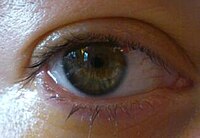
Photo from wikipedia
Purpose: To report a case of a patient with unilateral Adie’s pupil who underwent bilateral cataract extraction with multifocal and monofocal posterior chamber intraocular lens (IOL) implantation. Methods: A 74-year-old… Click to show full abstract
Purpose: To report a case of a patient with unilateral Adie’s pupil who underwent bilateral cataract extraction with multifocal and monofocal posterior chamber intraocular lens (IOL) implantation. Methods: A 74-year-old woman presented to our institution complaining of worsening near vision. Gross examination revealed a 6-mm fixed pupil on the right eye (OD) and a 5-mm pupil reacting to 3 mm with light on the left eye (OS). Slit lamp examination revealed a tonic pupil with an exaggerated pupillary constriction to dilute pilocarpine OD. Dilated exam revealed 2–3+ nuclear and cortical lens changes bilaterally. The patient’s active lifestyle, personality, and biometry measurements made her a good candidate for multifocal IOL (MfIOL) implantation OS. Femtosecond laser-assisted cataract extraction with a ReSTOR +3 ADD (SN60D1) implantation was performed OS. Monofocal lens implantation (SN60WF) was performed OD 6 months later. Results: One year postoperatively, our patient had an uncorrected visual acuity (VAsc) of 20/15 for distance and J10 for near OD. Her VAsc was 20/25 +1 for distance and J1 for near OS. Visual acuity when using both eyes was 20/15 for distance and J1 for near. Conclusion: Optimizing success for MfIOL implantation is a multifactorial process. Large pupils preoperatively are of particular concern, as this may lead to increased dysphotopsia with pupil-dependent MfIOLs. Thus, patients with unilateral mydriasis, such as Aide’s pupil, may have a beneficial outcome combining multifocal-monofocal implantation after bilateral cataract extraction, especially if they are not a candidate for monovision but desire spectacle independence.
Journal Title: Case Reports in Ophthalmology
Year Published: 2018
Link to full text (if available)
Share on Social Media: Sign Up to like & get
recommendations!